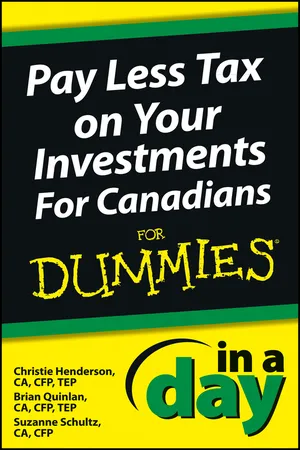Chapter 1
Minimizing Taxes on Your Investment Income
In This Chapter


We often hear people say, “My taxes are too high. I wish there were a way to reduce them!” Although we don’t have a magical solution that will make your tax bill disappear, we can suggest some things you can do to reduce the amount you pay, particularly if you’re an investor.
In this chapter we teach you the basics of tax-smart investing, how to pay less tax on your investments, and the rules of foreign investments. We also introduce some tax-advantaged investments you may not have thought of.
The Basics of Being a Tax-Savvy Investor
If you are an investor looking to maximize your returns, it’s not what you earn but what you keep after-tax that matters. Therefore, it’s necessary to consider many factors that are personal to you and which affect that after-tax return in order to properly construct an investment portfolio. These moving parts include your risk tolerance, your need for cash flow, the types of investment accounts you own, and your personal tax rate. A perfectly tax-efficient portfolio should not necessarily be your goal. First and foremost, choose investments that will allow you to sleep at night. But where it’s appropriate, choosing tax-efficient investments can help you keep more of your investment returns.
Tax efficiency doesn’t matter when you own only registered investments or have a Tax-Free Savings Account. Why? Earnings in these accounts accumulate tax-free regardless of the type of return. You’re taxed on your registered accounts only when you make withdrawals, and even then the type of underlying investment doesn’t matter. The full withdrawal is taxed at your full marginal tax rate. Withdrawals from Tax-Free Savings Accounts are tax-free.
On the other hand, investment returns in a non-registered account (also called a cash account) are not created equal in the eyes of the taxman. In fact, the amount of tax you pay depends on the type of income your investment is earning, whether that’s dividends, capital gains, or interest. To complicate matters further, the amount of tax on the different types of investment returns will differ depending on which tax bracket you’re taxed in. You also have to consider the impact of the investment income on other tax tested deductions, credits, or benefits you might qualify for such as the age credit, Old Age Security Benefits and medical credits.
Always weigh your investment and tax objectives before making any investment decision. Even though a particular investment suits you tax-wise, it may not fit your investment-risk profile.
Choose the best location for your investments
You may be lucky enough to have accumulated, over time, investment assets in registered, non-registered, and tax-free savings accounts. Some Canadians also have investment holding companies and maybe even family trusts or in-trust accounts for minor children. After you have more than one “location” in which to make investment choices, consider where it makes the most sense, tax-wise, to make each investment.
After you figure out what you want to hold, you can choose the best location for each type of investment. You would generally want fixed-income investments inside your registered accounts, where that highly taxed interest income can be earned tax-sheltered. Dividend-paying Canadian equities are great in a non-registered account, so you can take advantage of the dividend tax credit. Equities that have great growth potential are a good choice for a TFSA, because the growth will never be taxable nor will the eventual withdrawal — so letting that account grow as much as possible makes a lot of sense. Depending on how much money you have to work with in each account, there will likely be some overlap as well. That’s okay. This is just a starting point.
Choose tax-smart investments
It pays to pay attention to how your various forms of investment income are taxed — like all things in taxland, each scenario has its pros and cons. In this section we look at tax-effectively managing your income from dividends, capital gains, and interest.
Canadian dividends have their advantages
A dividend is a distribution of a corporation’s profits to its shareholders after all expenses and income taxes have been paid. Investors receive dividends on the stocks they purchase in their investment portfolios. If you’re looking to generate dividend income, you want to invest in Canadian equities (either directly or via a mutual fund) that pay dividends annually.
Canadian dividends are a tax-efficient source of investment income because they qualify for a special dividend tax credit, which keeps the tax burden low. Canadian dividends are always taxed at a lower rate than interest income and are usually taxed at lower rates than capital gains. Dividends are taxed at higher rates than capital gains only in a few provinces at the higher tax brackets (we’re talking significant differences only, with about $100,000-plus of taxable income). Ernst & Young’s website is particularly helpful in determining the tax rate that will apply to your income — use their tax calculator to find out, based on your current income level, what your marginal tax rate will be on regular income (including interest), dividends, and capital gains.




